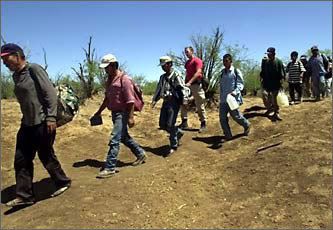Arizona looks at new warning system for migrants
 With the peak season for triple-digit heat and migrant deaths quickly approaching in the Arizona desert, a controversial new program as been proposed by an Arizona doctor to provide a "a probability of death" index for would-be migrants. The new initiative would be similar to other standard weather warnings but would predict the likelihood of death for those migrants attempting to cross the border from Mexico.
With the peak season for triple-digit heat and migrant deaths quickly approaching in the Arizona desert, a controversial new program as been proposed by an Arizona doctor to provide a "a probability of death" index for would-be migrants. The new initiative would be similar to other standard weather warnings but would predict the likelihood of death for those migrants attempting to cross the border from Mexico.
State officials plan to roll out Dr. Samuel Keim's prognosticating report stating which days will have the greatest probability of death for migrants before the summer heat peaks.
"By May, we will have an extreme heat warning based upon increasing probabilities that deaths will occur among border crossers," Keim said. "From four consecutive years of data, we have found that as the temperature on a given day reaches 104, the probability of death among the border crossers in [Pima] County reaches 50 percent."
Border deaths--and efforts to alleviate them, such as installing water stations--are fiercely debated in a state that has become the nation's busiest area for smuggling illegal immigrants. Even getting an accurate toll is contentious, as a federal audit recently criticized how the Border Patrol could be undercounting border deaths, which doubled over 10 years to 472 in 2005, mostly in Arizona.
Chicago Tribune
Keim, an associate professor at The University of Arizona Department of Emergency Medicine, published the first scientific journal article to investigate the public health issue of heat-related deaths among immigrants crossing into Arizona
"Estimating the Incidence of Heat-Related Deaths Among Immigrants in Pima County, Arizona," published in the April, 2006 issue of the Journal of Immigrant and Minority Health, examined the heat-related deaths recorded by the Pima County Medical Examiner between 1998-2003.
Last month, his findings were confirmed when the Binational Migration Institute (BMI) of the University of Arizona’s Mexican American Studies and Research Center published "The 'Funnel Effect' & Recovering Bodies of Unauthorized Migrants Processed by the Pima County Office of the Medical Examiner, 1990-2005", a report that examined more than 900 autopsy reports from the Pima County Medical Examiner's Office from 1990 to 2005.
Though some observers wonder whether Keim's chance-of-death forecast plan would dissuade anyone, Keim said the perennial body count has grown to "a public health concern."
"These people are dying on U.S. soil. This is a U.S. issue. It's not a Mexico issue. If 100 people died anywhere in a single county from exposure, I think it would make national news," said Keim, 46, an associate professor of emergency medicine at the University of Arizona.
"Whoever is willing to listen, if the temperature reaches a certain figure, we're going to say that there's this X, Y or Z risk for crossing the border," he added. "We're hoping it will provide a probability of death for the day so that people can say there is a 50-50 probability that at least one or more crossers will die if they cross the border."
Chicago Tribune
Anti-immigrant activists oppose Keim's plan on the grounds that it amounts to "aiding and abetting" illegal activity.
Barbara Coe, an activist who's conducted civilian patrols of the border in Arizona and elsewhere with the Minuteman Project, excoriated Keim's proposal as "criminal."
"That's called aiding and abetting," said Coe, also founder of the California Coalition for Immigration Reform. "Illegal aliens are criminals.
"Nobody wants anybody to die. I can tell you that the blood of these people [is] on the hands of the Mexican government . . . and corrupt U.S. politicians who welcome them to come to our country illegally," she said. "They can save their own lives by staying home."
Chicago Tribune
Other life saving initiatives have been criticized in the past, particularly those of church groups like Humane Borders who put water stations in the desert, with tall flags for easy location and No More Deaths who supply medical aid to migrants injured or suffering from the heat while crossing the Arizona desert.
State and local health officials support Keim's idea, especially as a hotter-than-normal summer is forecast this year. Longtime border area residents know how to avoid triple-digit heat and are more likely to be exposed to a thunderstorm or flood warning than a heat advisory, a Pima County health spokeswoman said. Migrants, however, come from all over Latin America and many may not know how deadly the Sonoran Desert can be, officials said.
…snip…
As the hot season approaches, the Border Patrol is stepping up its year-round Spanish public service announcements in Mexican and U.S. media under a campaign called "No mas cruces en la frontera," which translates to "no more crosses on the border."
"It's a very good idea," Border Patrol senior agent Jim Hawkins of Tucson said of Keim's plan. "I can't endorse what he's doing one way or another. I'm just saying we do the same thing" under the public announcements.
Chicago Tribune
As the season of increased death approaches, the debate over the program is bound to heat up as restrictionists like Coe and her minutemen friends attempt to block any attempt to save lives and prevent suffering in the scorching desert along the southern border.
Related from Migra Matters:
"US border policy increases migrant deaths 20-fold in Arizona desert" Feb 2007
"Border fence boondoggle, it's more than just the cost" Jan 2007
"Walking in the footsteps de los fantasmas" June 2006
"Meet the "most dangerous" people on our southern border" Jan 2006
"A Must Read Story" Jan 2006
tags: immigration, AZ , migrant death, heat index

































No comments:
Post a Comment